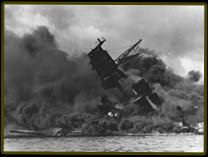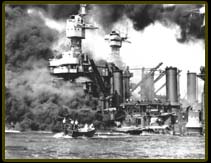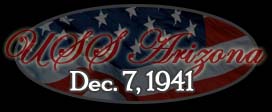|
The attack on Pearl Harbor
was part of a grand strategy of conquest in the Western Pacific. The
objective for the Japanese was to immobilize the Pacific Fleet so that
the United States could not interfere with their invasion plans.
Japanese aircraft appeared
in the air
|
 |
|
over Pearl Harbor just
before 8:00 am on that Sunday, December 6th, morning. The color detail
was on deck in anticipation of raising the flag at the stern at 8:00.
The Arizona came under attack almost immediately, and at about 8:10
received a hit by a 800-kilogram bomb just forward of turret two on
the starboard side. Within a few seconds the forward powder magazines
exploded, gutting the forward part of the ship. The foremast and forward
superstructure collapsed forward into the void created by the explosion
and turrets one and two, deprived of support, dropped more than 20 feet
relative to their normal position. The explosion ignited furious fires
in the forward part of the ship.
|
The attack was a great, but not total success. Although the U.S. Pacific
Fleet was shattered, Its aircraft carriers (not in port at the time of
the attack) were still afloat and Pearl Harbor was surprisingly intact.
The shipyards, fuel storage areas, and submarine base suffered no more
than slight damage. More importantly, the American people,
|
 |
previously
divided over the issue of U.S. involvement in World War II, rallied together
with a total commitment to victory over Japan and her Axis partners.
During the following months and years of World War II, the destruction
of the Arizona came to symbolize the reason the U.S. was fighting.
|

